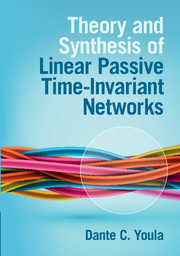Book contents
- Frontmatter
- Contents
- Preface
- 1 Auxiliary results
- 2 Transforms and passivity
- 3 Some classical passive 1-port synthesis
- 4 Tellegen's Theorem and 2-element 1-ports
- 5 Elements of filters and reactance-ladders
- 6 Passive n-ports
- 7 Procedures of passive n-port synthesis
- 8 Basic design of reactance 2-ports
- 9 Cascade synthesis of passive 1-ports
- 10 A theory of broadband matching
- 11 Stability and complex normalization
- 12 Design of passive multiplexers
- 13 Selected topics
- 14 Multiconductor TEM transmission lines
- 15 The ideal TEM 2-port
- 16 Single frequency n-port geometry
- 17 Immittances of n-terminal networks
- 18 Two-state passive devices
- Index
- References
14 - Multiconductor TEM transmission lines
Published online by Cambridge University Press: 05 November 2015
- Frontmatter
- Contents
- Preface
- 1 Auxiliary results
- 2 Transforms and passivity
- 3 Some classical passive 1-port synthesis
- 4 Tellegen's Theorem and 2-element 1-ports
- 5 Elements of filters and reactance-ladders
- 6 Passive n-ports
- 7 Procedures of passive n-port synthesis
- 8 Basic design of reactance 2-ports
- 9 Cascade synthesis of passive 1-ports
- 10 A theory of broadband matching
- 11 Stability and complex normalization
- 12 Design of passive multiplexers
- 13 Selected topics
- 14 Multiconductor TEM transmission lines
- 15 The ideal TEM 2-port
- 16 Single frequency n-port geometry
- 17 Immittances of n-terminal networks
- 18 Two-state passive devices
- Index
- References
Summary
Introduction
The validity of lumped circuit analysis hinges critically on the assumption that all electrical signals, such as voltage and current, although time-dependent, do not vary continuously with position. Such will indeed be the case if the physical size of any component in the network is much less than the wavelength of the excitation produced in the component by external sources. In the microwave band, however, frequencies range from 1 to 10 GHz and corresponding wavelengths vary from 0.3 to 0.03 meters. It is often impossible, or prohibitively expensive to accurately design discrete components whose dimensions are negligibly small compared with 3 centimeters. Our study of the 1-dimensional TEM line with the aid of field theory will reveal that low-frequency techniques are sometimes applicable, in the small.
Analytical formulation
A transverse electromagnetic or TEM wave is one in which the electric and magnetic field vectors lie in a plane perpendicular to the direction of propagation (which we shall assume to be along the longitudinal z-axis). This is the principal type of wave supported by the structures in Figs. 14.1 (a, b, and c) formed by embedding n + 1 parallel ideal cylindrical conductors in a homogeneous isotropic dielectric. Naturally, even excellent conductors such as gold and platinum are not perfect and have finite conductivities σ(ω). And, of course, neither are they infinitely long. This combination of loss and end-effects inevitably leads to the appearance of longitudinal field components and propagation is not truly TEM. Nevertheless, these z-components attenuate very rapidly as they progress into the interior of such metals and in general contribute negligibly to the field in the bulk of the dielectric.
Information
- Type
- Chapter
- Information
- Theory and Synthesis of Linear Passive Time-Invariant Networks , pp. 481 - 524Publisher: Cambridge University PressPrint publication year: 2015
